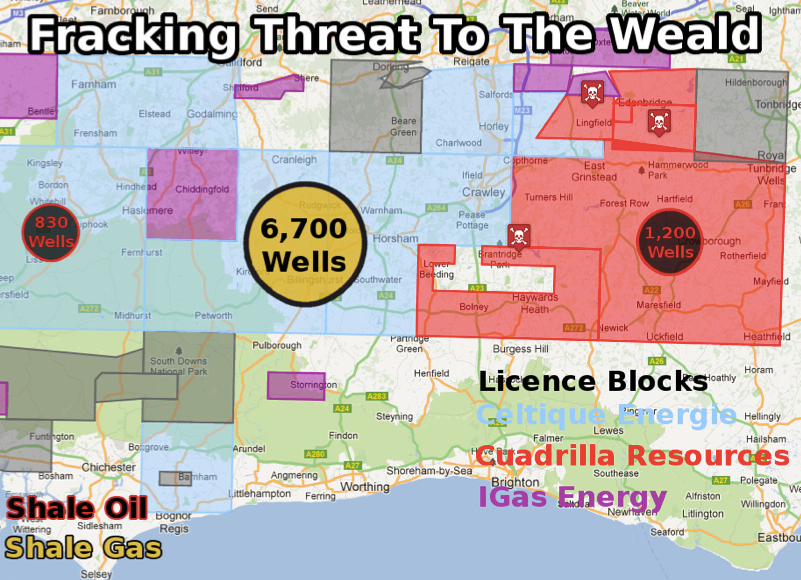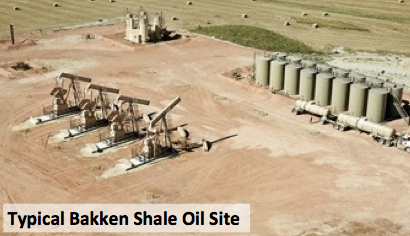Summary
- Fracking is now threatening Sussex
- Cuadrilla has licence blocks in the east
- Celtique Energie has blocks in the west
- Unconventional prospects in Sussex
- Kimmeridge Clay and deeper Lias
- Kimmeridge is presently main target
- Analogous to Bakken Shale in North Dakota
- Would require drilling thousands of wells
- Cuadrilla want to drill at Balcombe soon
- Celtique have plans for two sites in Sussex
- Near Fernhurst and Wisborough Green
As easier to extract fossil fuels are being used up, the system is resorting to more extreme energy extraction methods. Horizontal drilling and hydraulic fracturing are increasingly being used by the petroleum industry to extract unconventional oil and gas, which is trapped in low permeability rock. In Sussex, as with much of the UK, the government has already sold off large areas for exploitation by oil and gas companies, and are threatening to sell off much more within the next year. Cuadrilla Resources have 4 licences covering over 270 square miles in the eastern half of Sussex. To the west, Celtique Energie/Magellan Petroleum own a number of licence blocks stretching right across West Sussex.
 In the Weald Basin, between the North and South Downs, and extending east-west through Hampshire, Kent and Sussex, there are two geological formations, the Kimmeridge Clay and the Lias Shale, which could potentially be exploited for unconventional gas or oil. It should be noted that the use of the word shale in shale gas (or oil) is not very precise and can in fact refer to any fine grained (low permeability) sedimentary rock. Shale plays in the US exploit a wide variety of these rocks (e.g. in Texas the Barnett Shale play exploits siliceous mudstones while the Eagle Ford Shale exploits bituminous shales).
In the Weald Basin, between the North and South Downs, and extending east-west through Hampshire, Kent and Sussex, there are two geological formations, the Kimmeridge Clay and the Lias Shale, which could potentially be exploited for unconventional gas or oil. It should be noted that the use of the word shale in shale gas (or oil) is not very precise and can in fact refer to any fine grained (low permeability) sedimentary rock. Shale plays in the US exploit a wide variety of these rocks (e.g. in Texas the Barnett Shale play exploits siliceous mudstones while the Eagle Ford Shale exploits bituminous shales).
The Kimmeridge Clay is named after Kimmeridge Bay in Dorset, where the formation is exposed at the surface. The Kimmeridge Clay is a layer of organic rich mudstone which is the source rock (where the oil or gas formed) for a large fraction of the oil and gas that has been produced in northern Europe. However, targeting oil and gas which is still trapped within the Kimmeridge Clay is a unconventional prospect which would require much more extreme extraction methods. The depth of the formation varies across the Weald but is generally quite shallow and more likely to contain oil than gas.
The Lias formation are considerably deeper than the Kimmeridge Clay and consists of alternating layers of limestone and clay. The formation is over 600m thick at the centre of the basin and due to its greater depth has a great chance of the organic matter having been conveted into petroleum. In the central part of the Weald (mostly in West Sussex) the Lias is deep enough that it is likely to contain gas rather than oil. However just containing oil or gas is not enough and the rock to have specific set of properties (hard enough to fracture while not being too dense) in order for there to be any chance of extraction.
Cuadrilla has announced plans to drill an exploration well at its Balcombe site beginning soon. Specifically Cuadrilla plan to drill and take samples of the rock in a vertical well drilled to approximately 3,000 feet. They are targeting the shallower Kimmeridge Clay rather than the deeper Lias. They then plan to pull back and drill a 2,000 foot long horizontal off the main wellbore at a depth of about 2,600 feet. The horizontal will target a layer of micrite (lime mud) within the Kimmeridge Clay formation. Cuadrilla have stated that they will stimulate the well by injecting hydrochloric acid (an acid frack). If this acid job does not prove enough then they could potentially hydraulic fracture the well.
This is the first stage of a much larger process
 Cuadrilla are exploring for shale (tight) oil, like the Bakken Shale in North Dakota. Shale oil usually involves targeting somewhat higher permeability layers, adjacent to or embedded with source rocks. In the Bakken wells are drilled into a siltstone/sandstone layer. In a similar way Cuadrilla is targeting a micrite layer within the Kimmeridge Clay. In the Bakken all the wells are heavily fracked with up to 40 frack stages along a 9,500 foot horizontal wellbore. Wells were initially drilled at a spacing of around 1 per square mile but infilling to 4 wells per square mile is now becoming common.
Cuadrilla are exploring for shale (tight) oil, like the Bakken Shale in North Dakota. Shale oil usually involves targeting somewhat higher permeability layers, adjacent to or embedded with source rocks. In the Bakken wells are drilled into a siltstone/sandstone layer. In a similar way Cuadrilla is targeting a micrite layer within the Kimmeridge Clay. In the Bakken all the wells are heavily fracked with up to 40 frack stages along a 9,500 foot horizontal wellbore. Wells were initially drilled at a spacing of around 1 per square mile but infilling to 4 wells per square mile is now becoming common.
At a spacing of 4 wells per square mile, full scale development could mean 32 wells within the parish and over 300 within 5 miles of the village. Cuadrilla have produced no estimates, but at a spacing of 4 wells per square mile development could mean up to 1,200 wells in Cuadrilla’s licence blocks in Sussex. Possibly more for shale gas development. A vast network of pipelines, compressor stations and processing plants would be needed to support such a development.
In West Sussex Celtique Energie are planning to submit planning applications for 2 unconventional wells near Wisborough Green and Fernhurst. As Cuadrilla are doing they are planning to target tight limestone layers within the Kimmeridge Clay, with horizontal wells. Unlike Cuadrilla though Celtique have been bragging extensively about the shale oil and gas they hope to be able to extract. The volume of oil and gas they are promising to shareholders would require over 6,000 shale gas wells and 800 shale oil wells in West Sussex.
The industry’s own research shows that over time most wells will leak (over half leak in some way within 15 years). The extraction process involves the use of a cocktail of toxic chemicals in both the drilling and fracking fluids. The volumes of water used in these processes are also huge (millions of gallons per well). Flowback fluids will also leach materials out of the targeted formations, including heavy metals, toxic hydrocarbons and radioactive materials. Leaking methane, toxic water contamination, severe air pollution, chronic health effects and cancers have devastated communities in the US and Australia. People there have woken up to the threat and are getting organised.

